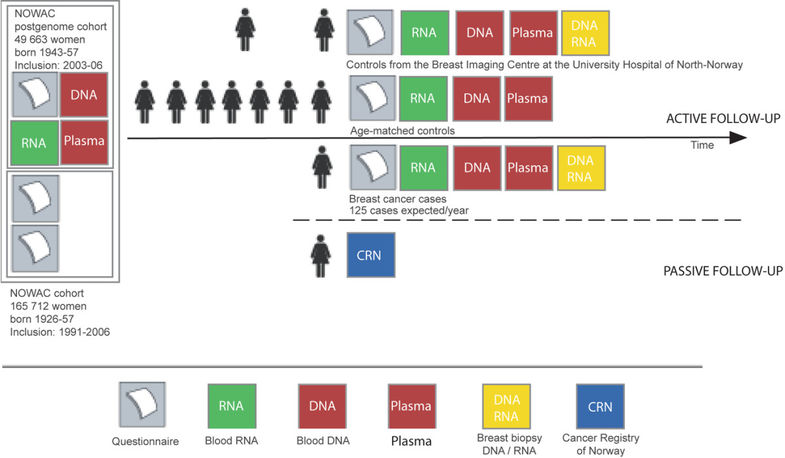Abstract
The introduction of high-throughput technologies, also called -omics technologies, into epidemiology has raised the need for high-quality observational studies to reduce several sources of error and bias.
The Norwegian Women and Cancer (NOWAC) postgenome cohort study consists of approximately 50,000 women born between 1943 and 1957 who gave blood samples between 2003 and 2006 and filled out a two-page questionnaire. Blood was collected in such a way that RNA is preserved and can be used for gene expression analyses. The women are part of the NOWAC study consisting of 172,471 women 30 to 70 years of age at recruitment from 1991 to 2006 who answered one to three questionnaires on diet, medication use, and lifestyle. In collaboration with the Norwegian Breast Cancer Group, every NOWAC participant born between 1943 and 1957 who is admitted to a collaborating hospital for a diagnostic biopsy or for surgery of breast cancer will be asked to donate a tumor biopsy and two blood samples. In parallel, at least three controls are approached for each breast cancer case in order to obtain blood samples from at least two controls per case. The controls are drawn at random from NOWAC matched by time of follow-up and age. In addition, 400 normal breast tissues as well as blood samples will be collected among healthy women participating at the Norwegian Mammography Screening program at the Breast Imaging Center at the University Hospital of North-Norway, Tromsø.
The NOWAC postgenome cohort offers a unique opportunity (a) to study blood-derived gene expression profiles as a diagnostic test for breast cancer in a nested case-control design with adjustment for confounding factors related to different exposures, (b) to improve the reliability and accuracy of this approach by adjusting for an individual’s genotype (for example, variants in genes coding for hormone and drug-metabolizing and detoxifying enzymes), (c) to study gene expression profiles from peripheral blood as surrogate tissue to biomonitor defined exposure (for example, hormone) and its association with disease risk (that is, breast cancer), and (d) to study gene variants (single nucleotide polymorphisms and copy number variations) and environmental exposure (endogenous and exogenous hormones) and their influence on the incidence of different molecular subtypes of breast cancer.
The NOWAC postgenome cohort combining a valid epidemiological approach with richness of biological samples should make an important contribution to the study of the etiology and system biology of breast cancer.
